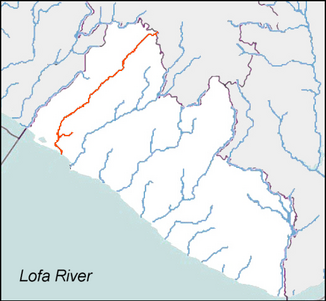Lofa (river)
|
Lofa Little Cape Mount River |
||
| Data | ||
| location |
West Africa Guinea Liberia |
|
| River system | Lofa | |
| Source height | 940 m | |
| muzzle |
Atlantic Ocean Coordinates: 6 ° 34 '6 " N , 11 ° 2' 55" W 6 ° 34 '6 " N , 11 ° 2' 55" W |
|
| Mouth height | 0 m | |
| Height difference | 940 m | |
| Bottom slope | 2.3 ‰ | |
| length | 410 km | |
| Catchment area | 10,612 km² | |
| Discharge at the Lofa Bridge gauge (03LO001) A Eo : 8194 km² Location: 79 km above the estuary |
NNQ (21.03.2016) MNQ 2012–2019 MQ 2012–2019 Mq 2012–2019 MHQ 2012–2019 HHQ (09.09.2013) |
2 m³ / s 25 m³ / s 248 m³ / s 30.3 l / (s km²) 780 m³ / s 1314 m³ / s |
| Left tributaries | Lawa , Budulu Creek, Mahe | |
| Right tributaries | Yambasei Creek | |
| Navigable | not navigable | |
The Lofa (English: Lofa River), also known as Little Cape Mount River , is a river in West Africa , bordering the republics of Liberia and Guinea (only headwaters). The Lofa is not navigable due to countless rapids and shallows, but it has been used by Africans for centuries as a transport route with boats and dugouts.
course
The Lofa has a catchment area of 10,612 km², it rises in the prefecture of Macenta in the southeast of the Republic of Guinea , flows through the western part of the Republic of Liberia ( Lofa , Gbarpolu and Bomi county) and flows south of Bomboja into the Atlantic . In the middle reaches the river meets the mountain range Wonegizi Range and flows through the Kpelle National Forest .
Hydrometry
The flow of the river changes constantly with the seasons:
- on the upper reaches, at the hydrographic station Dougami, Liberia, catchment area 236 km², the maximum is reached in September, it is 123.9 m³ / s, the minimum is registered in February with 4.6 m³ / s.
- on the lower reaches, at the hydrographic station "Lofa Bridge (03LO001)", Liberia, catchment area 8 194 km², the highest measured discharge in September 2013 was 1314 m³ / s and the minimum in March 2016 was 2 m³ / s. The average discharge is 31 m³ / s (see diagram).

fauna
On the upper reaches of the Lofa there is a distribution area of the pygmy hippopotamus , where a pair of these rare animals was caught by the German African explorer Hans Schomburgk in 1911 on behalf of the New York Zoological Society and brought to the USA on adventurous routes.
raw materials
At the Lofa , diamonds and gold deposits were discovered as early as the 19th century; these are operated by local gold prospectors and adventurers without the use of modern mining technology. There are extensive rubber plantations on the lower reaches .
Web links
- TK250 NC29-14 (GUÉKÉDOU) , US Army Map Service (Ed.), Washington 1954, (headwaters in Guinea)
- TK250 NB29-4 (MONROVIA) , US Army Map Service (Ed.), Washington 1960, (Course in Liberia)
literature
- JW Lugenbeel: The republic of Liberia: its geography, climate, soil and productions, with a history of its early settlements . GS Stockwell, New York 1868, p. 299 (English, limited preview in Google Book search).
Individual evidence
- ^ A b Liberian Hydrological Services - Lofa River Principal Basin Tables, Figures and Maps
- ↑ Liberia River Basins 2016 - Drainage Divisions and River Basin Boundaries
- ↑ a b Flow rates on Liberian Hydrological Services
- ↑ The State of the Environment (SOE) Report 2006. (PDF; 2.8 MB) (No longer available online.) United Nations Development Program, 2006, p. 37 , archived from the original on April 11, 2009 ; accessed on January 30, 2011 (English). Info: The archive link was inserted automatically and has not yet been checked. Please check the original and archive link according to the instructions and then remove this notice.
- ^ Lofa River (1186). (No longer available online.) In: River Discharged Database, Gaylord Nelson Institute, University of Wisconsin – Madison . Archived from the original on June 18, 2010 ; Retrieved January 30, 2011 . Info: The archive link was inserted automatically and has not yet been checked. Please check the original and archive link according to the instructions and then remove this notice.
- ^ At last New York has a pair of Pygmy Hippos. (PDF) New York Times , December 14, 1912, accessed January 30, 2011 .
